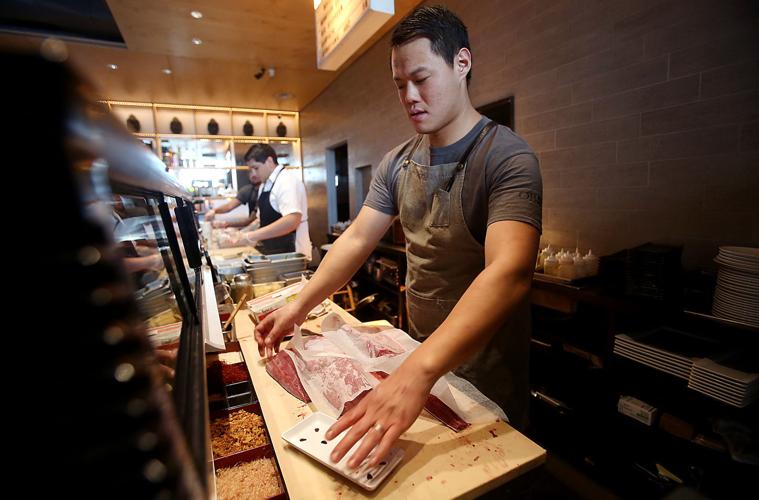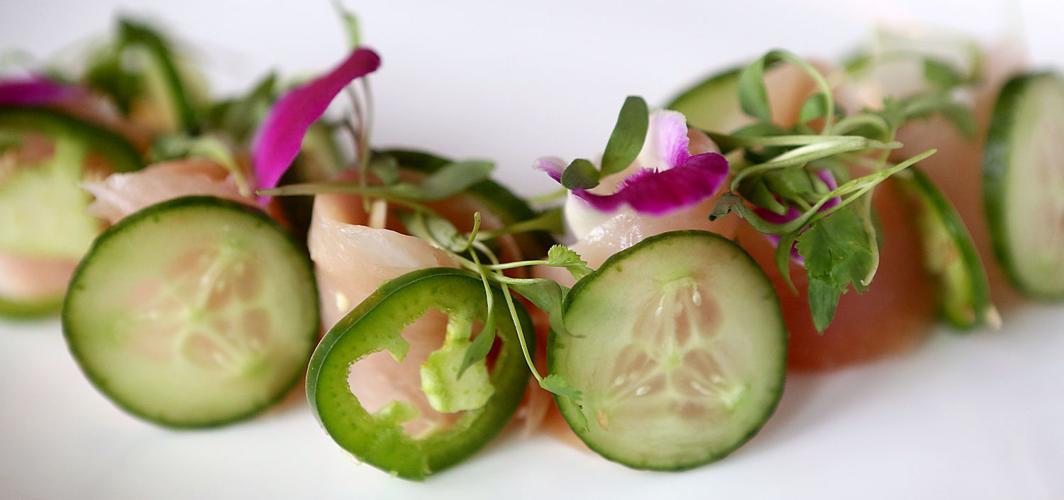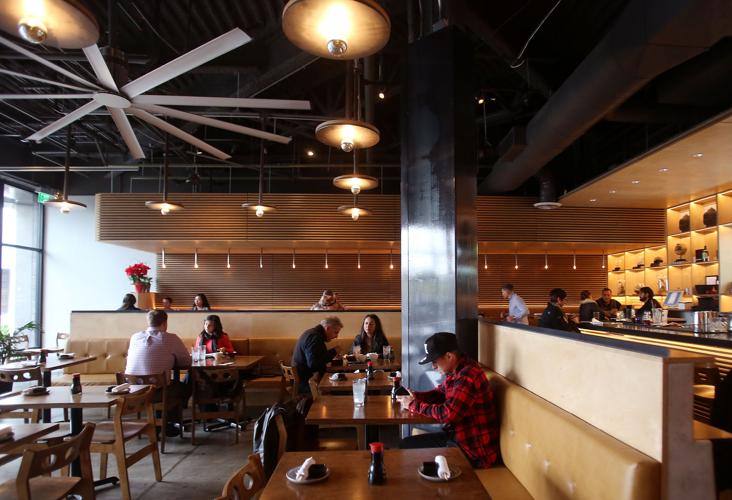It’s the holidays, and everywhere we look we are tempted with sweet richness. Christmas tree-shaped cookies over there. Nuts covered in cinnamon sugar over here.
We need an antidote, and Obon Sushi + Bar + Ramen just might be it.
The purity of raw fresh fish and the complexity of a good ramen are a far step away from seasonal sweets.
A bit of background: Obon opened in August in the downtown space once occupied by Gio Taco. It’s got a Zen-like vibe, with pale wood and soft lighting. Brandon Katz is behind the restaurant — he is a veteran of Fox Restaurant Concepts and learned all about sushi when he worked at RA Sushi Bar Restaurant. He also learned about service, and it was gracious and informed at Obon.
The chef is Paulo Im, who has an extensive experience as a sushi chef. And while he seems to honor tradition, his menu, which is heavy with Japanese and Korean influences, makes it clear that tradition doesn’t mean same old-same old.
About that menu: While ramen is in the name, only three versions are offered. And forget about an extensive sushi menu. There are plenty of choices, but you aren’t going to find the multipage menus many Asian restaurants offer. There is a blackboard above the sushi bar listing the daily specials. You definitely want to check those out.
What we missed: Sides of wasabi didn’t come with the dishes, which was just fine with us — we trust the chef to prepare the food the way it should be eaten. But we missed the pickled ginger — it serves as a palate cleanser, and if you plan to sample lots of fish, you want that.
Let’s get started: It’s hard to resist dumplings ($7.50), but you might want to here: the pork filling was under seasoned — we longed for more fresh ginger. And we had hoped for dumplings that had been flash fried on one side, leaving the other soft and supple. The whole dumpling was fried — not our favorite way. And the pork belly steamed bun ($4.25) was more like a pork belly steamed bun taco style — rather than wrapped up securely in the center, the tender pork sat in a folded fluffy steamed roll. That would have been OK if it hadn’t so, well, boring.
Ramen romance: Here’s the thing about ramen — if the broth is blah, you’ve failed. The broth at Obon is rich, clearly cooked slowly, and gorgeously complex. It pulls much of its flavor from the pork bones that the liquid cooks in, and it is just the right amount of salty and fat. The broth comes to the table packed with color, textures and shapes — green scallions, the yellow and white of an egg with a still-soft yolk, thin disks of narutomaki (little fish cakes). Slices of pork shoulder and belly sit next to long, curly noodles that catch the broth and make slurping them up into the mouth a smooth delight. Slurping is allowed, and not just because it’s polite to do it loud and often in Japan. There’s something about slurping that enhances the broth and the ramen experience. The noodles passed the not-too-mushy test. (They are not made there, but “are the best you can get” the waiter assured us.) The Obon Ramen ($11.75) has a few shakes of black garlic oil; the Tonkotsu ($10.75) adds red chile oil, giving it a slight heat that seemed to underscore, rather than overpower, the other flavors. Both were warm, comforting and complex, but that added red chile oil made the Tonkotsu our favorite.
Fishy stuff: Sure, you can get traditional sushi and nigiri here, but branch out a bit — Chef Im certainly has. His Monster Roll ($14), for instance. It is what its name says — a huge sushi roll packed with crunchy shrimp tempura; crispy soft shell crab; silky cream cheese; cool cucumber, and snappy asparagus. Too much? Nah. It was a celebration of textures and flavors — and big enough that one roll is a meal in itself. From the “Modern Nigiri” section of the menu, we dipped into the Waluu Tataki ($7.50). That’s brave of us — walu (how it is traditionally spelled) is escolar, a white fish that contains a fat called wax esters, which humans can’t digest (and so should not be eaten in abundance). Honest. There are two small pieces in the Odon dish, lying on a finger of rice. They were lightly grilled and a bit tougher than they should have been, but the taste shouted the sea.
Also smacking of freshness: The Akami Tuna ($7.50), a hefty hunk of ahi tuna dressed up with shiitake mushrooms and a barely spicy horseradish aioli.
The Hamachi Serrano ($7) matches yellowtail with fresh ginger and a serrano — it packs a bit of heat and a load of flavor, and the Flying Fish Roe ($4.50) was loaded with black roe (thanks, no doubt, to an infusion of squid ink — the natural color for the roe is a red-orange) and the small eggs had a slight crunch and a hint of a smoky flavor.
On the blackboard on one of our visits was monkfish liver ($6). Often called the “foie gras of the sea,” we rarely see this on menus. Plus, it is in season during the colder months. Of course we had to try it. The liver, wrapped in seaweed, is creamy and rich and carries just a salty whisper of the ocean. There were just two pieces on the plate, but they are so deliciously rich, two was all that was needed.
Meat Obon’s way: We are big fans of the Korean dish bulgogi, so when we saw the Bulgogi Ribeye Steak ($14.50) on the menu it was hard to resist. Thin strips of the buttery rib eye sat next to sweet sautéed onions and earthy mushrooms. Bulgogi is traditionally a messy pile of thin strips of meat with a variety of sauces, lettuce, green peppers, sometimes garlic; this plate was so tidy it was almost disappointing. And it was on the sweet side – tasting more like teriyaki steak than bulgogi. But that’s the thing about Odon — it often gives a nod to tradition, then goes its own way.
For the most part, we like the way it goes.








